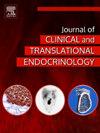Effect of GIP and GLP-1 infusion on bone resorption in glucose intolerant, pancreatic insufficient cystic fibrosis
IF 3.3
Q1 ENDOCRINOLOGY & METABOLISM
Journal of Clinical and Translational Endocrinology
Pub Date : 2025-04-07
DOI:10.1016/j.jcte.2025.100392
引用次数: 0
Abstract
Context
Diabetes and bone disease are common in cystic fibrosis (CF) and primarily occur alongside exocrine pancreatic insufficiency (PI). “Incretins,” glucose-dependent insulinotropic polypeptide (GIP) and glucagon-like peptide 1 (GLP-1), augment insulin secretion and regulate bone metabolism. In CF, PI dampens the incretin response. Loss of the insulinotropic effect of GIP in CF was recently identified, but effects on bone are unknown.
Objective
Determine effects of incretins on bone resorption markers in adults with PI-CF.
Design
Secondary analysis of a mechanistic double-blinded randomized placebo-controlled crossover trial including adults ages 18–40 years with PI-CF (n = 25).
Intervention
Adults with PI-CF received either GIP (4 pmol/kg/min) or GLP-1 (1.5 pmol/kg/min) infusion, followed by double-blind randomization to either incretin or placebo infusion. Non-CF healthy controls received double-blind GIP (4 pmol/kg/min) or placebo. Serum C-terminal telopeptide (CTX), a bone resorption marker, was assessed during the infusion over 80 (GIP) or 60 (GLP-1) minutes.
Main Outcome Measures
CTX (mg/dL) concentrations.
Results
In PI-CF, CTX decreased during GIP infusion, but not during placebo (time-by-treatment interaction P < 0.01). GLP-1 did not affect CTX. In non-CF healthy controls, time-by-treatment interaction was not significant (P = 0.23), but CTX decreased during GIP (P = 0.02) but not placebo (P = 0.47).
Conclusions
GIP evokes a bone anti-resorptive effect in people with PI-CF. Since the incretin response is perturbed in PI-CF, and an infusion of GIP lowers bone resorption, the “gut-bone axis” in CF-related bone disease requires attention.
GIP和GLP-1输注对糖不耐受胰不全囊性纤维化患者骨吸收的影响
背景糖尿病和骨病是囊性纤维化(CF)的常见病,主要与胰腺外分泌功能不全(PI)同时发生。"胰岛素"、葡萄糖依赖性促胰岛素多肽(GIP)和胰高血糖素样肽 1(GLP-1)可促进胰岛素分泌并调节骨代谢。在 CF 中,PI 会抑制增量素反应。最近发现 GIP 在 CF 中失去了促胰岛素作用,但对骨骼的影响尚不清楚。目的确定增量素对 PI-CF 成人骨吸收标志物的影响。干预患有 PI-CF 的成人接受 GIP(4 pmol/kg/min)或 GLP-1(1.5 pmol/kg/min)输注,然后双盲随机输注增量素或安慰剂。非中风健康对照组接受双盲 GIP(4 pmol/kg/min)或安慰剂输注。在输注 80 分钟(GIP)或 60 分钟(GLP-1)期间,评估血清 C 端端肽(CTX)(一种骨吸收标志物)。GLP-1 不影响 CTX。在非 CF 健康对照组中,时间与治疗的交互作用不显著(P = 0.23),但在注射 GIP 期间 CTX 下降(P = 0.02),而安慰剂期间 CTX 不下降(P = 0.47)。由于 PI-CF 患者的增量素反应受到干扰,而 GIP 的输注可降低骨吸收,因此 CF 相关骨病中的 "肠-骨轴 "需要引起关注。
本文章由计算机程序翻译,如有差异,请以英文原文为准。
求助全文
约1分钟内获得全文
求助全文
来源期刊

Journal of Clinical and Translational Endocrinology
ENDOCRINOLOGY & METABOLISM-
CiteScore
6.10
自引率
0.00%
发文量
24
审稿时长
16 weeks
 求助内容:
求助内容: 应助结果提醒方式:
应助结果提醒方式:


